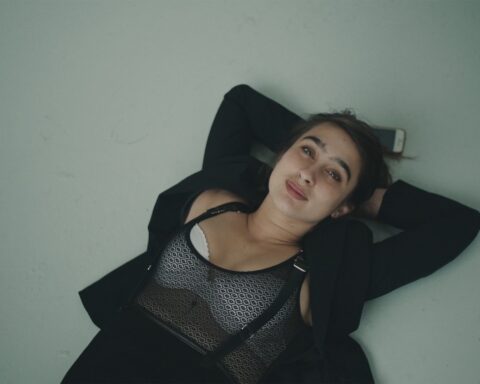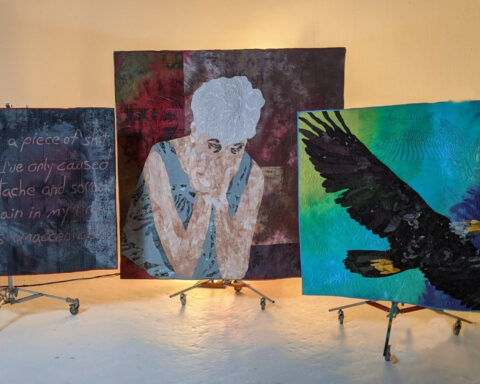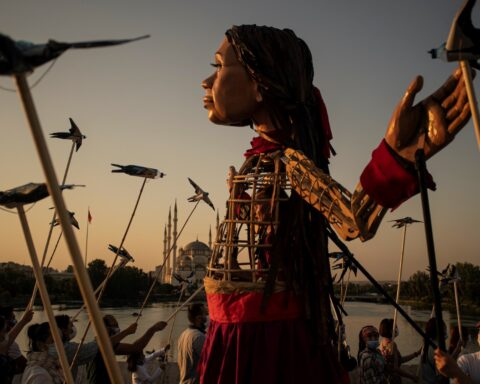It’s a well-worn critical cliché to say that a particular film is “as boring as watching paint dry.” In Corinna Belz’s excellent new documentary Gerhard Richter Painting, that critique is turned on its head as one watches enthralled at the broad, confident brushstrokes of its eponymous subject. Shot over three years in and around Richter’s studios in Cologne, the film is a portrait of the artist as an old man; what’s impressive is how, even at the age of 79, Richter seems willing to refine, and even redefine, his vision. The long, frequently dialogue-free takes show him labouring over a piece and then just as quickly squeegeeing the paint into new patterns, apparently on a whim. Gesturing towards two hastily slathered abstract canvases, bold riots of red and blue on school-bus yellow, he says that he yearns for a way of working that is “just as fast and fancy free, but would leave them finished, too. These won’t last.”
It’s an ironic statement, since the film, one of the major titles of Toronto’s Reel Artists Film Festival, running February 22 to 26 at TIFF Bell Lightbox, is, if nothing else, an advertisement for its subject’s staying power. Despite his ambivalence about the spotlight, which Belz’s film captures both in its present-tense sequences and archival interviews, Richter is an international icon, but, as usual, Reel Artists has balanced its programme between films about household names and films spotlighting lesser-known figures. Hence Gerhard Richter Painting can be slotted in next to profiles of the comparatively obscure Japanese photographer Hiroshi Sugimoto and the gifted Canadian filmmaker Mark Lewis. “We’re committed to screening films about Canadian artists as well as films about internationally recognized artists,” says the festival’s lead programmer, Ann Webb, who is also the executive director of the Canadian Art Foundation. “And beyond the films, we’re interested in connecting filmmakers with each other when they visit the festival and with the Toronto community.”
This coming together of the art-world circuit and the art-house circuit makes RAFF a unique proposition, even in a city with as many film festivals as Toronto (approximately 2,158, at last count). At the same time, there’s something familiar about RAFF’s physical trajectory in the past two years away from its previous screening venues across the city and toward the Lightbox, which has lately become the epicentre of Toronto film culture. Where some local programmers have fretted off the record about the perceptual effects of other festivals utilizing TIFF branded screen space, Webb isn’t worried. “I don’t consider our festival to be under the umbrella of TIFF, and so far neither do our audience members,” she says. “We have a distinct brand and very loyal filmgoers.”
Looking over this year’s lineup, it’s fair to say that that brand is improving. In the past, RAFF’s mandate to showcase non-fiction about artists, as opposed to dramatic features about artists, or, more crucially, experimental cinema made by artists, combined with its placement at the beginning of the calendar year (which is actually at the wrong end of the festival calendar year), resulted in limited programming options. Now, it seems that there are more films on the table. “Our search [for material] is broader than it used to be” Webb confirms. “Directors now approach us with their material. There’s more being made available to us, in different formats and at different lengths. Over the past few years, there have been many more feature-length documentaries about artists, and in many cases, we’re able to present world or Canadian premieres.”
The biggest splash will probably be made by the Canadian premiere of Marina Abramovic: The Artist is Present, directed by Matthew Akers. Named after its sexagenarian subject’s headline-grabbing MOMA exhibition—where she sat silently in a special area from opening to closing hours for three months, interacting with patrons by looking into their eyes, one at a time, for as long a period as they desired—the film examines the physical and emotional boldness of an artist who has used her own body as a canvas for the better part of 40 years.
Webb calls The Artist is Present “one of the most moving and compelling visual art documentaries that [she’s] ever seen.” High praise, but it’s at least arguable that it does more to introduce a wide audience to a great, pioneering performance artist than Wim Wenders’ lauded but conceptually fuzzy 3-D hit Pina (a film that seems more about its director’s virtuosity than the life and ethos of Pina Bausch). The film’s structure is familiar from any number of other films about artists, counting down to the MOMA exhibit while flashing back to different points in her career (Gerard Richter Painting does much the same thing, though more methodically). The conventionality of the film’s construction actually creates an interesting tension, however, when balanced against Abramovic’s wilder impulses: it’s as if the store-bought doc format can barely contain her.
The sequences shot during the MOMA exhibition capture something of the immediacy and intimacy of Abramovic’s highbrow David Blaine stunt. There are memorable close-ups of the patrons’ faces as they collapse into helpless, grateful tears once Abramovic meets their gaze (though she doesn’t look up when a girl is dragged away by museum security after stripping down in an attempted show of artistic solidarity). Emotional ballast arrives in the form of Ulay (Uwe Laysiepen), the German performance artist who was Abramovic’s personal and artistic partner for a decade before they parted ways. One of the hooks of Akers’ film is the scenes where Ulay and Abramovi´c reconnect, which have a tender, tentative quality totally apart from the latter’s public persona.
Abramovic’s combination of authentic fearlessness and self-promotional savvy makes her an immediately compelling subject, and The Artist is Present, which is due for a wide theatrical release in June, will have no trouble attracting an audience. But she’s not the only provocateur on display at RAFF. There’s also the North American premiere of Peter Scharf and Katja Duregger’s The Rage of Images, which focuses on the ferocious Italian photographer Oliviero Toscani, who shot a series of the most widely scrutinized, and loudly denounced, ads for Benetton in the 1990s: striking, at times graphic and incongruously religious images that didn’t seem to have much to do with selling designer shirts.
Instead, Toscani was engaging in a high stakes art project using one of the world’s most recognizable brand names as both patron and canvas. Embedding challenging sociopolitical messages into his photos—a white baby sucking at a black breast; a black hand clutching a few meagre grains of rice—he succeeded at what so many brash artists claim to do: infiltrating and then productively reframing the mainstream. A jovial, unpretentious man who seems to enjoy both public and private jokes, Toscani got Benetton to run an ad during the first Gulf War showing a newborn baby, surely a symbol of hope, and then turned right around and created a complementary billboard of a soldier’s bloody T-shirt and camouflage that was lambasted as opportunistic “shock advertising”.
The Rage of Images inventories the criticisms that Toscani was exploiting or aestheticizing human suffering, as in his Middle-American Pietà of an AIDS-stricken man surrounded by his family on his deathbed, while giving him plenty of screen time to clarify his own intentions. At 42 minutes, The Rage of Images can’t offer much more than a concise overview of its subject’s career, but it’s also possible that a longer treatment would have belaboured the point, especially since Toscani’s admirably sincere and articulate defences of his work are far less powerful and persuasive than the photos themselves.
If Toscani’s work is articulate, the tableaux vivants of the Toronto-based photographers Carol Condé and Karl Beveridge are positively loquacious: proof that sometimes a picture really is worth a thousand pointed words. Their photo collages, which use a combination of stately classicism and sly postmodernism to probe global states of social, economic and religious inequality, are multilayered and elaborately staged, often using real activists as models. Their strange, surreal juxtapositions have an aesthetic power that heightens the political content, creating a sense of outrage melded to a sense of humour.
Roz Owen’s fine documentary Portrait of Resistance similarly works on two levels: as an informative primer for the uninitiated on a major body of work in modern Canadian art, and as a deeply affectionate profile of a couple who’ve lived and worked together for four decades. Owen conceived the film when she and her longtime collaborator Jim Miller (the film’s editor and producer) met with Condé and Beveridge for dinner in 2007, when the photographers were working on a monumental piece modelled after Brueghel’s epochal painting Fall of the Rebel Angels. Their version, entitled The Fall of Water, recast the Battle in Heaven as a sprawling, violently contested fight over two kinds of flow: that of water and, more importantly, cash which determines who controls the worldwide supply. The visual quotations of Brueghel are quite specific, replacing the painter’s seven-headed dragon with headshots of the heads of seven major water corporations. It’s not subtle, but then neither was Brueghel (who, coincidentally, was also paid homage to in the Polish artist Lech Majewski’s extraordinary 2011 feature The Mill and The Cross).
“I was struck by the extraordinary beauty and complexity and depth of ideas that they were working with,” says Owen. “When I sat down for dinner it popped out of my mouth: ‘We have to make a film about you two.’” Appropriately enough, given its title, Portrait of Resistance begins in the furor and confusion of the 2010 G20 protests in Toronto, with Condé and Beveridge, both of whom are in their sixties, standing gamely in the middle of the fray. It’s an arresting overture that speaks to the ongoing commitment of two people who got their counterculture bona fides back in the 1960s, when they were art-school loiterers in Yorkville.
It also illustrates their eye for a good story. Given that so many of their collages depict riotous clashes between symbols of authority and the underclass, the teeming throng of the G20 was fertile ground for inspiration, the logical follow-up to projects where they have documented and aestheticized labour struggles and union activities.
“It was very chaotic filming at the G20,” says Owen. “I was worried about getting the shots we needed and Jim was worried about our camera being confiscated or that I would get arrested. It’s a strange position when you are documenting an event rather than participating as you see things that perhaps others who are caught up in chanting don’t.”
Owen’s observation could double as an apt assessment of Condé and Beveridge’s attempts to look at the bigger picture, a trend borne out in the way that they literally removed images of themselves from their work after the 1970s. Owen and Miller have a little fun with their subjects’ self-effacement. In one memorable sequence, their ruminations on avoiding self portraiture are interrupted when a seemingly static figure in the photo collage behind them comes to life to give them a hard time about their camera-shyness.
The man is radical filmmaker John Greyson, and as he begins to wax rhapsodic about Condé-Beveridge’s trademark form of “visual or photographic karaoke” and its place within art history, the pair flees the frame, a pretty good meta-joke about their modesty. “Carole and Karl didn’t want the film to be about them,” says Owen, “but about their work and the community of people they work with. They never wanted to be the stars.I think that this created some of the dramatic tension in the film and is definitely why we named it Portrait of Resistance.”
At the same time, there is a personal dimension to the film. A sequence describing how Condé and Beveridge overcame the potential pitfall of competition early in their careers—“art is about being an individual,” says Condé—is intercut with footage of them trying to build a bench for one of their photos. The DIY endeavour ends on the first go-round with a pile of discarded wooden planks; a simple but effective visual metaphor for the idea that collaboration is something that you have to work at.
Owen’s film is itself a clear labour of love, produced without much of a financial safety net. She says that in the two years that it took her and Miller to raise the money to make Portrait of Resistance, Condé and Beveridge had completed the other three paintings after The Fall of Water in their “elemental” quartet. But she and Miller saw the project through, mirroring their subjects’ dedication to their own palpably independent practice. “More than anyone I’ve ever known, Carole and Karl have lived according to their principles,” Owen says. “Given the fact that the world is now living through a financial crisis—the clear result of deregulation and greed—I think it’s time for people to pay more attention to the ideas of Condé and Beveridge. In many ways, with the Occupy movement capturing attention, the world is only just catching up to them.”











